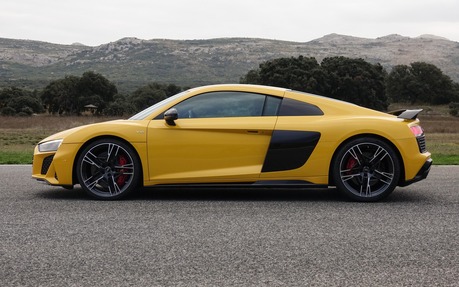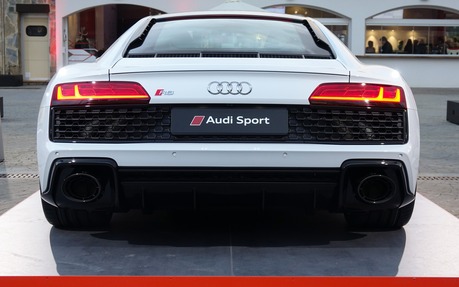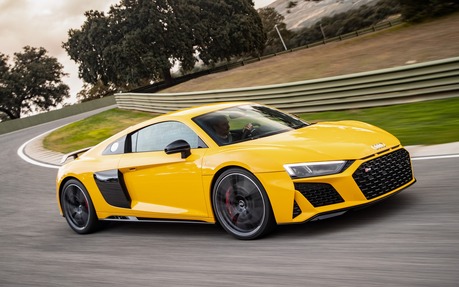2020 Audi R8 V10 performance quattro: Racing is in its Blood
RONDA, Spain – It came as no surprise that Audi decided to introduce its new sports car at the Ascari circuit and gave us the chance to drive a few R8 Coupes on the track. It’s no coincidence either that the manufacturer offered us rides in the R8 LMS GT3 race car, driven by professional drivers.
What’s the connection? These vehicles were developed in parallel by Audi Sport GmbH, the racing and performance division, and were the predecessors to the second-gen R8 released for 2017. In fact, they still share almost half their parts, with this proportion climbing above 60% for the R8 LMS GT4.
- Also: Significant Updates for the 2019 Audi R8
- Also: Audi R8 LMS GT3: This Race Car Shows the New Face of the R8
Of course, Audi loves racing and their team has been thumb twiddling ever since it withdrew from the endurance championship after winning several titles and 13 victories at the 24 Hours of Le Mans. These accomplishments include the 2003 win of the Bentley Speed 8, which was essentially an Audi with a roof painted in British Racing Green. In comparison, the electric Formula E is a soft drug.

Traits From More than One Family
Viewed from the side, the R8 production model and GT3 look very much alike, especially the silhouette and proportions. Obviously this doesn’t include the GT3’s large adjustable spoiler or its lower stance and substantially reduced ground clearance. The black elongated hexagon grille is bigger and no longer has a chrome contour. There are three slots right above it as a nod to the legendary Sport Quattro and vertical fins separate the side air intakes.
Aluminum body panels surround the second generation’s boxed frame, which is lighter, more rigid and contains 14% carbon-fibre-reinforced polymers. The R8 shares the main components of this structure with its cousin, the Lamborghini Huracán.
Their naturally aspirated engines, now very rare in this category, are almost identical too. The tamest is the 5.2-litre V10 that pumps out 562 horsepower at 8000 rpm in the R8 V10 quattro. That's nearly 30 horsepower more than before. The more brazen engine unleashes 611 horsepower in the R8 V10 performance quattro, for an increase of just under 10 horsepower.

This should be plenty to blast the Coupe version of the V10 quattro to 100 km/h in 3.4 seconds and the V10 performance quattro in 3.1 seconds. This comes with help from the seven-speed dual-clutch gearbox’s launch control mode, which pushes the revs to 4500 rpm before starting. The all-wheel drive system and mechanical limited-slip rear differential do the rest. Add one tenth of a second for Spyder versions whose hydraulic roof adds 44 kilograms.
Awakening the Beast
To be frank, with short overhangs and sleek aerodynamic lines, the R8 looks downright timid next to its extroverted rivals. Even with the V10 performance’s chiselled front end and fixed rear spoiler. Even with a redesigned rear treatment, which flaunts horizontal lines, rests on an extractor that’s as sculpted as the GT3’s, and is flanked by massive oval exhaust tips.

But all that is quickly forgotten when you press the start button. That’s when the fabulous naturally aspirated V10 roars to life. Its raspy voice grows louder as the needle on the virtual rev counter pushes toward the red zone, which starts at 8500 rpm. It now offers Lamborghini-like musicality—and that’s a good thing.
In full acceleration, the V10’s wail is one of the R8 V10 performance quattro’s best assets, but it’s certainly not the only one. I realized this right from the first corner, as I struggled to keep pace with an R8 driven by a pro who knew every nuance of the Ascari circuit, which is characterized by fast corners, long curves and inclined turns.
Comfortably pressed into a nicely sculpted bucket seat, I rediscovered the same finesse and flexibility that I have always loved about the R8, ever since the first version. The front end enters corners without the slightest hesitation. The Michelin tires only slip by a hair’s worth, the vehicle pivots gently and you’re free to accelerate as hard as you want. Or just about. Even with 611 horses running wild behind you.
Obviously, the rear slips if you go too hard or too abruptly, but it’s easy to catch it with a little countersteering. I didn’t notice any difference between the electric power steering and the optional dynamic steering. That’s because the steering ratio is set to 14:1 when you select more advanced driving modes. And the R8 V10 performance vehicles now boast seven, which is three more than what their sisters have.
Still Quietly Magical
Whether you order it in Ascari Blue, Kemora Gray or Vegas Yellow, the V10 performance is equally breathtaking in lateral accelerations. With the right pedal pushed flat, it nails to the pavement. All four wheels slip ever so slightly and it approaches the 1.5 G that its engine can manage without oil starvation, thanks to the dry sump used to bolt the V10 lower for an ideal centre of gravity.
The optional carbon-ceramic brakes are 11 kilograms lighter, yet powerful and unflappable. The all-aluminum suspension has been refined and those who want can add a carbon-fibre anti-roll bar up front, which weighs 2 kilograms less. And, importantly, the vehicle has kept the magnetic ride shocks that have ensured an exceptional experience since Day 1.
Based on all this, I expect that the new R8 V10 quattro and V10 performance quattro will still be superior road vehicles in a category where unruly and fussy pure-breds are all too common. It should follow in the footsteps of the first generation, which could even pass as a snowmobile in winter storms. And with the colder months upon us again, you can still take it to the track for a few laps of pure thrills.
| Test drive report | |
| Test model | 2020 Audi R8 |
|---|---|
| Trim level | V10 performance quattro |
| Price range | N/A |
| Price as tested | N/A |
| Warranty (basic) | 4 years/80,000 km |
| Warranty (powertrain) | 4 years/80,000 km |
| Fuel economy (city/highway/observed) | N/A |
| Options | N/A |
| Competitive models | Acura NSX, Lamborghini Huracán, Mercedes-Benz AMG GT, Nissan GT-R |
| Strong points |
|
| Weak points |
|
| Editor's rating | |
| Fuel economy | Its fuel consumption is proportional to the substantial engine displacement and impressive performance |
| Comfort | Excellent on the track and probably on the road too, given its magnetorheological dampers and outstanding seats |
| Performance | Insane naturally aspirated V10 offering great sound, power, flexibility and fast-climbing revs |
| Infotainment | Superb digital display right in front of the driver, with simple and efficient controls for the A/C and other systems |
| Driving | A rare, if not entirely unique, combination of power, road holding and pure driving pleasure |
| Overall | A thoroughbred sports car that is exceptional across the board, but will nonetheless have trouble standing out in a highly competitive category |
